1994 CHEVROLET CAVALIER fuel pressure
[x] Cancel search: fuel pressurePage 11 of 243
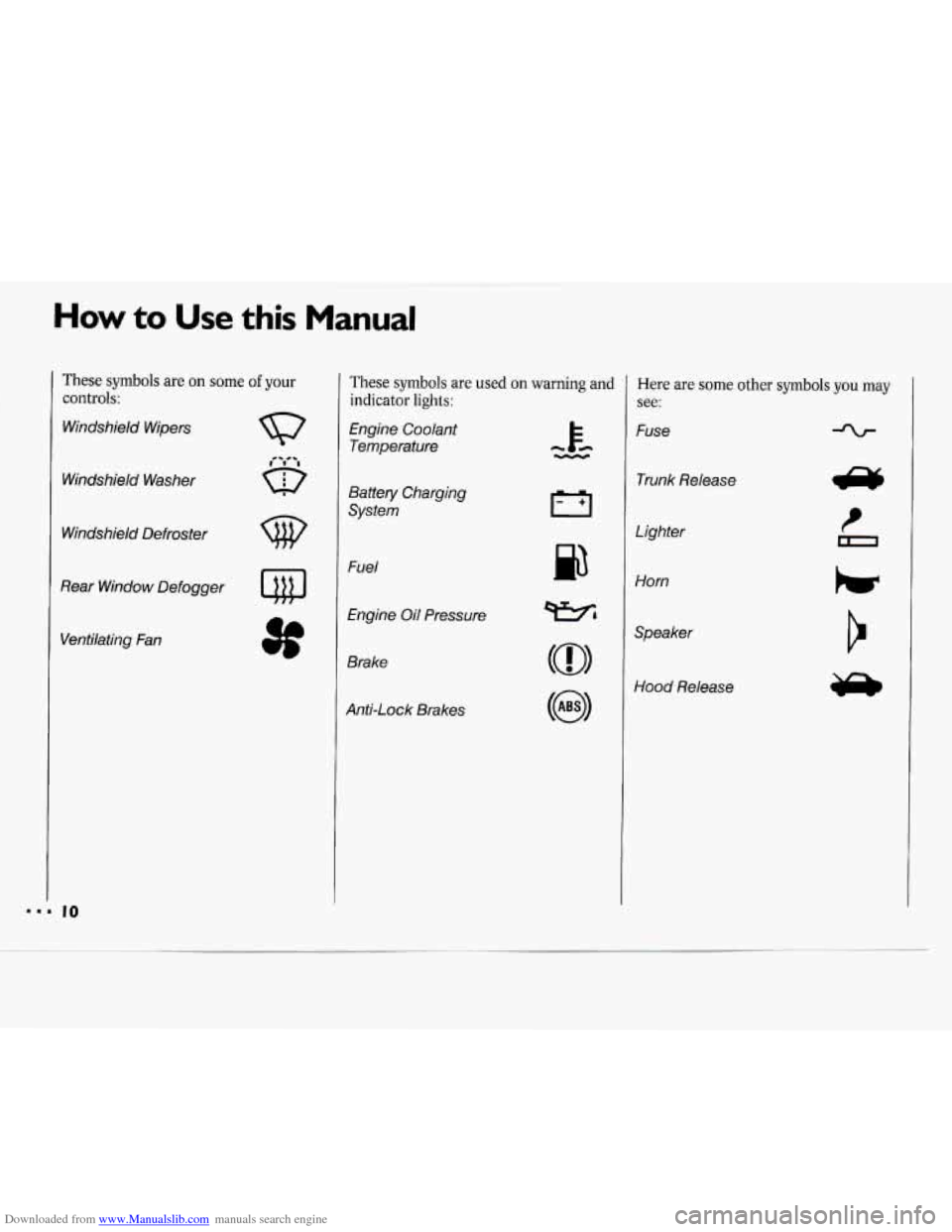
Downloaded from www.Manualslib.com manuals search engine How to Use this Manual
These symbols are on some of your
controls:
Windshield Wipers
Windshield Washer
Windshield Defroster
Rear Window Defogger
Ventilating Fan
These symbols are used on warning and
indicator
lights:
Engine Coolant
Temperature
Battery Charging
System
Fuel
Engine Oil Pressure
Brake
Anti-Lock Brakes
p3
Here are some other symbols you may
see:
Fuse
Trunk Release
Lighter
Horn
Speaker
Hood Release
Page 90 of 243

Downloaded from www.Manualslib.com manuals search engine r
c
CHECK ’
OAGES
NOLANT J
D)(8,
I
Check Gages Light
This light will come on briefly when yo1
are starting the engine. If the light
comes on and stays on while you are
driving, check your various gages to see
if they are in the warning zones.
This light will also come on when the
fuel level is low,
1 to 3 gallons (3.8 to
liters)
Oil Warning Light (2.2~ ~4 ENGINE)
If you have a low engine oil pressure
Iroblem, this light will stay on after yob
start your engine, or come on when you
ue driving. This indicates that your
mgine is not receiving enough oil. The
mgine could be low on
oil, or could haw
some other oil problem. Have it fixed
immediately.
The oil light could
also come on in two
other situations:
When the ignition is on but the engin
is not running, the light will come on
as a test to show you it is working,
but the light will go out when you
turn the ignition to
Start. If it doesn’l
come on with the ignition on, you
may have a problem with the fuse or
bulb. Have it fixed right away.
If you make a hard stop, the light may
come on for a moment.
This is normal.
NOTICE:
Damage to your engine from
neglected oil problems can be costly and is not covered by your
warranty.
Page 122 of 243
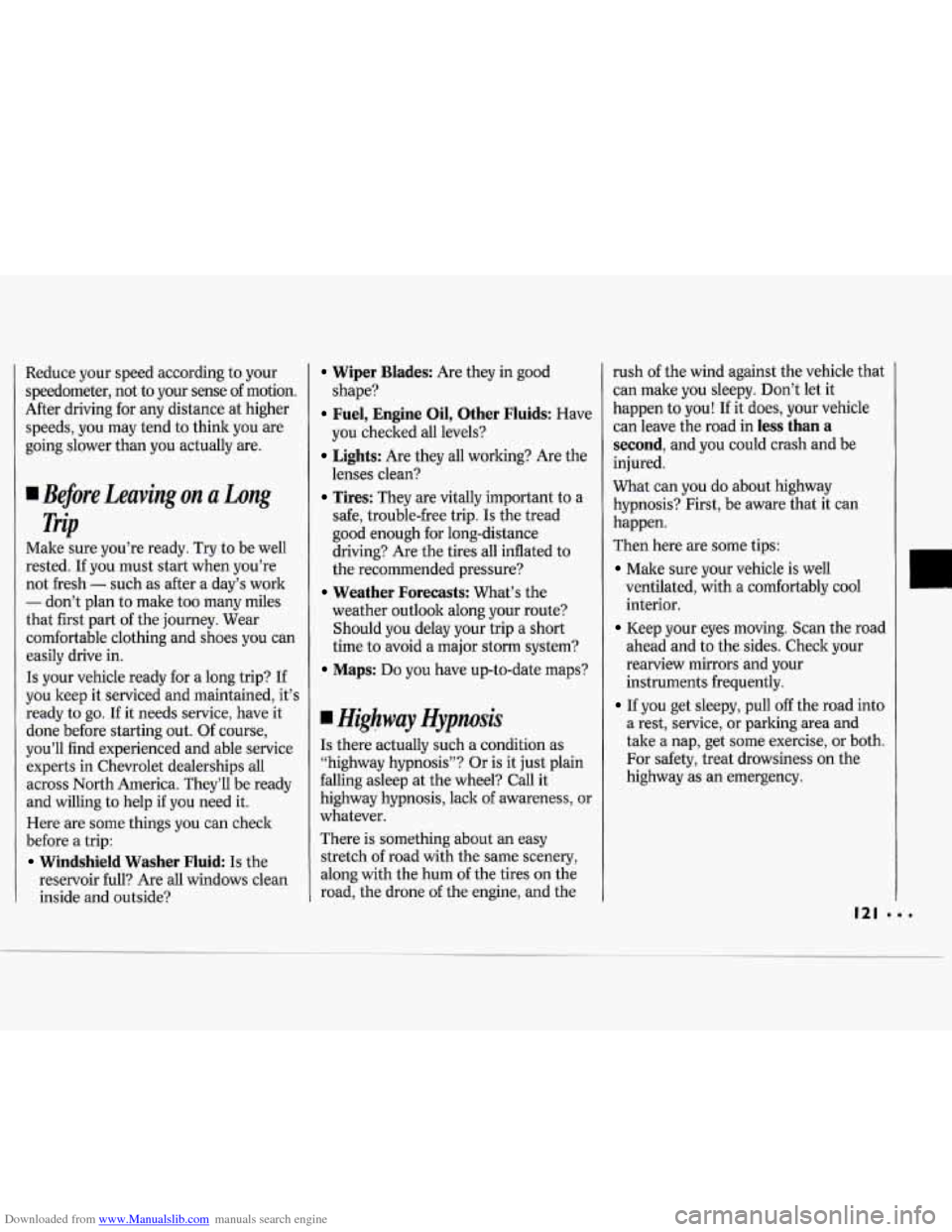
Downloaded from www.Manualslib.com manuals search engine Reduce your speed according to your
speedometer, not to your sense of motion.
After driving for any distance at higher
speeds, you may tend
to think you are
going slower than you actually are.
Before Leaving on a Long
Trip
Make sure you’re ready. Try to be well
rested.
If you must start when you’re
not fresh
- such as after a day’s work
- don’t plan to make too many miles
that first part
of the journey. Wear
comfortable clothing and shoes you can
easily drive in.
Is your vehicle ready for a long trip? If
you keep it serviced and maintained, it’s
ready to
go. If it needs service, have it
done before starting out. Of course,
you’ll find experienced and able service
experts in Chevrolet dealerships all
across North America. They’ll be ready
and willing to help
if you need it.
Here are some things you can check
before a trip:
Windshield Washer Fluid Is the
reservoir full? Are all windows clean
inside and outside?
Wiper Blades: Are they in good
shape?
Fuel, Engine Oil, Other Fluids: Have
you checked all levels?
Lights: Are they all working? Are the
lenses clean?
Tires: They are vitally important to a
safe, trouble-free trip.
Is the tread
good enough for long-distance
driving? Are the tires all inflated to
the recommended pressure?
weather outlook along your route?
Should you delay your trip a short
time to avoid a major storm system?
Maps: Do you have up-to-date maps?
Weather Forecasts: What’s the
Highway Hypnosis
Is there actually such a condition as
“highway hypnosis”? Or is it just plain
falling asleep at the wheel? Call it
highway hypnosis, lack
of awareness, or
whatever.
There is something about an easy
stretch of road with the same scenery,
along with the hum of the tires on the
road, the drone
of the engine, and the rush
of the wind against the vehicle that
can make you sleepy. Don’t let it
happen to you! If it does, your vehicle
can leave the road in
less than a
second,
and you could crash and be
injured.
What can you do about highway
hypnosis? First, be aware that it can
happen.
Then here are some tips:
Make sure your vehicle is well
ventilated, with a comfortably cool
interior.
Keep your eyes moving. Scan the road
ahead and to the. sides. Check your
rearview mirrors and your
instruments frequently.
If you get sleepy, pull off the road into
a rest, service, or parking area and
take a nap, get some exercise, or both.
For safety, treat drowsiness
on the
highway as an emergency.
a
Page 181 of 243

Downloaded from www.Manualslib.com manuals search engine Service & Appearance Care
I Loading Your Vehicle
Two labels on your vehicle show how
nuch weight it may properly carry. The
rire-Loading Information label found
In the rear edge of the driver's door
.ells you the proper size, speed rating
md recommended inflation pressures
or the tires on your vehicle. It also
:ives you important information about
.he number of people that can be in
four vehicle and the total weight that
rou can carry. This weight
is called the
Jehicle Capacity Weight and includes
.he weight
of all occupants, cargo, and
111 nonfactory-installed options. The other label is
the Certification label,
found on the rear edge of the driver's
door. It tells you the gross weight
capacity of your vehicle, called the
GVWR (Gross Vehicle Weight Rating).
The
GVWR includes the weight of the
vehicle, all occupants, fuel and cargo.
Never exceed the GVWR for your
vehicle,
or the Gross Axle Weight
Rating (GAWR) for either the front or
rear axle.
And, if you do have a heavy load, you
should spread it out. Don't carry more
than
132 lbs. (60 kg) in your trunk, or
88 lbs. (40 kg) in your wagon's rear
area. If you put things inside your vehicle -
like suitcases, tools, packages, or
anything else
- they will go as fast as
the vehicle goes. If you have to stop or
turn quicltly, or
if there is a crash,
they'll keep going.
Page 183 of 243
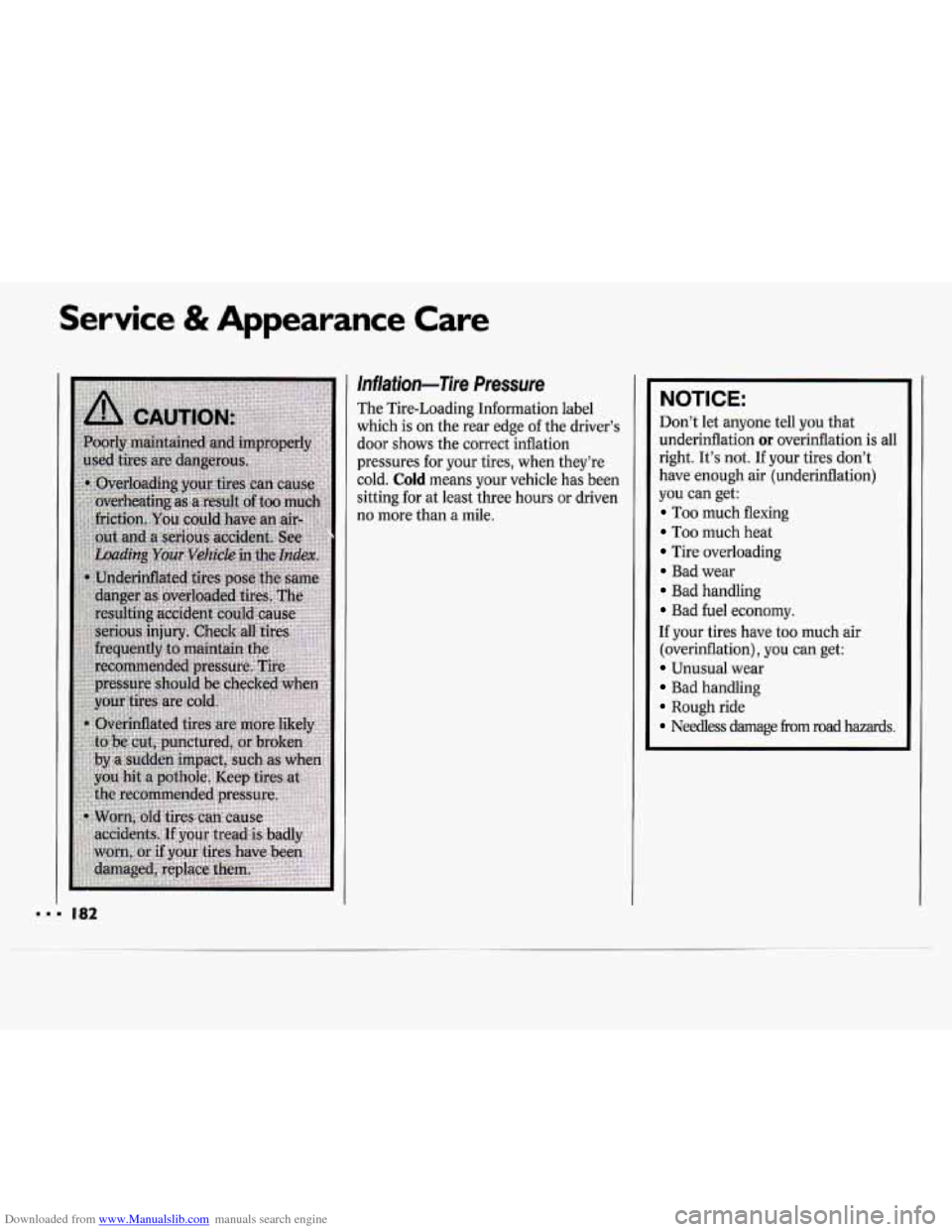
Downloaded from www.Manualslib.com manuals search engine Service & Appearance Care
Inflation-Tire Pressure
The Tire-Loading Information label
which is on the rear edge of the driver’s
door shows the correct inflation
pressures for your tires, when they’re
cold.
Cold means your vehicle has been
sitting for at least three hours or driven
no more than a mile.
NOTICE:
Don’t let anyone tell you that
underinflation
or overinflation is all
right. It’s not. If your tires don’t
have enough air (underinflation)
you can get:
Too much flexing
Too much heat
Tire overloading
Bad wear
Bad handling
Bad fuel economy.
If your tires have
too much air
(overinflation), you can get:
Unusual wear
Bad handling
Rough ride
Needless damage from road hazards.
Page 199 of 243

Downloaded from www.Manualslib.com manuals search engine Service & Appearance Care
Capacities & Specifications
Engine Crankcase ........................................................................\
.................. 4.0 quarts
When changing filter, up to 0.5 quart (0.5 liter) more oil may be needed.
Automatic Transaxle ........................................................................\
............
Pan Removal and Replacement ................................................................... 4.0 quarts
After Complete Overhaul
........................................................................\
... 6.9 quarts
When draining or replacing torque converter, more fluid may be needed.
Manual Transaxle ........................................................................\
.................
Complete Drain and Refill ........................................................................\
... 2.0 quarts
Cooling System ........................................................................\
.....................
2.2L L4 ........................................................................\
................................. 11.7 quarts
3.1L V6
........................................................................\
................................. 14.2 quarts
Refrigerant (R-12), Air Conditioning ........................................................ 2.25 pounds
Not all air conditioning refrigerants are the same. If the air conditioning
system in your vehicle needs refrigerant, be sure the proper refrigerant
is used. If you’re not sure, ask your Chevrolet dealer. For additional
information, see
your “Warranty and Owner Assistance
Information
” booklet.
Fuel Tank ........................................................................\
............................. .15.2 gallons
Power Steering
Pump Only ........................................................................\
........................... 1.00 pint
Complete System
........................................................................\
................. 2.25 pints 3.80
L
3.80
L
6.60 L
1.90
L
11.1 L
13.5 L
1.02 kg
57.5 L
0.50 L
1.25 L
Tire Pressures, Sizes ........................................................................\
............ See Tire-Loading Information label on driver’s door.
Wheel Nut Torque ........................................................................\
............... 100 pound-feet 140 Nom
NOTE: All capacities are approximate. When adding, be sure to fill to the appropriate level, as recommended in this manual.
Page 236 of 243
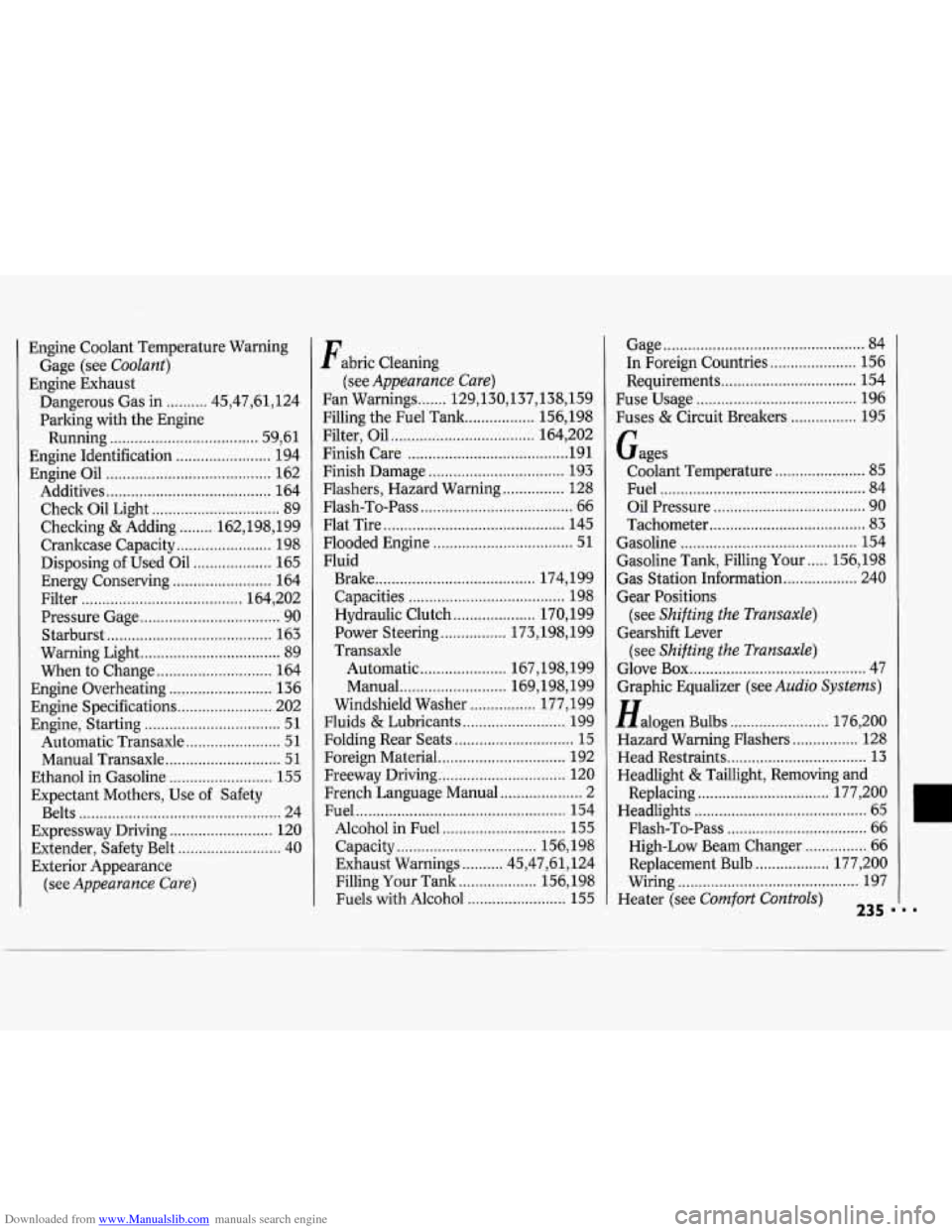
Downloaded from www.Manualslib.com manuals search engine Engine Coolant Temperature Warning
Engine Exhaust Gage (see
Coolant)
Dangerous Gas
in .......... 45.47.61. 124
Parking with the Engine
Running
.................................... 59. 61
Engine Identification
....................... 194
Engine Oil
........................................ 162
Additives
........................................ 164
Check Oil Light
............................... 89
Checking &Adding
........ 162.198. 199
Crankcase Capacity
....................... 198
Disposing of Used Oil
................... 165
Energy Conserving
........................ 164
Filter
....................................... 164. 202
Pressure Gage
.................................. 90
Starburst
........................................ 163
Warning Light
.................................. 89
When to Change
............................ 164
Engine Overheating
......................... 136
Engine Specifications ....................... 202
Engine. Starting
................................. 51
Automatic Transaxle
....................... 51
Manual Transaxle
............................ 51
Ethanol in Gasoline
......................... 155
Expectant Mothers. Use
of Safety
Belts
................................................. 24
Extender. Safety Belt
......................... 40
Exterior Appearance
Expressway Driving
......................... 120
(see Appearance
Care)
Fabric Cleaning
Fan Warnings
....... 129.130.137.138. 159
Filling the Fuel Tank
................. 156. 198
Filter. Oil
................................... 164, 202
Finish Care
....................................... 19 1
Finish Damage ................................. 193
Flashers, Hazard Warning
............... 128
Flash-To-Pass
..................................... 66
Flat Tire
............................................ 145
Flooded Engine
.................................. 51
Fluid Brake
....................................... 174, 199
Capacities
...................................... 198
Hydraulic Clutch
.................... 170. 199
Power Steering
................ 173,198, 199
Transaxle Automatic
..................... 167,198, 199
Manual
.......................... 169,198, 199
Windshield Washer
................ 177, 199
Fluids
& Lubricants ......................... 199
Foreign Material
............................... 192
Freeway Driving
............................... 120
French Language Manual
.................... 2
Fuel
................................................... 154
Alcohol in Fuel
.............................. 155
Capacity
.................................. 156, 198
Exhaust Warnings
.......... 45,47,61, 124
Filling Your Tank
................... 156, 198
Fuels with Alcohol
........................ 155
(see
Appearance
Care)
Folding Rear Seats ............................. 15
Gage ................................................. 84
In Foreign Countries ..................... 156
Requirements
................................. 154
Fuse Usage
....................................... 196
Fuses
& Circuit Breakers ................ 195
Gages Coolant Temperature
...................... 85
Fuel .................................................. 84
Oil Pressure
..................................... 90
Tachometer
...................................... 83
Gasoline ........................................... 154
Gasoline Tank, Filling Your
..... 156, 198
Gas Station Information
.................. 240
Gear Positions
Gearshift Lever
Glove Box
........................................... 47
Graphic Equalizer (see
Audio Systems)
Halogen Bulbs ........................ 176, 200
Head Restraints
.................................. 13
Headlight & Taillight, Removing and
(see
Shifting
the Transaxle)
(see Shifting the Transaxle)
Hazard Warning Flashers ................ 128
Replacing
................................ 177, 200
Headlights
.......................................... 65
Flash-To-Pass
.................................. 66
High-Low Beam Changer
............... 66
Replacement Bulb
.................. 177, 200
Wiring
............................................ 197
Heater (see
Comfort Controls) 235 1 . .
Page 238 of 243
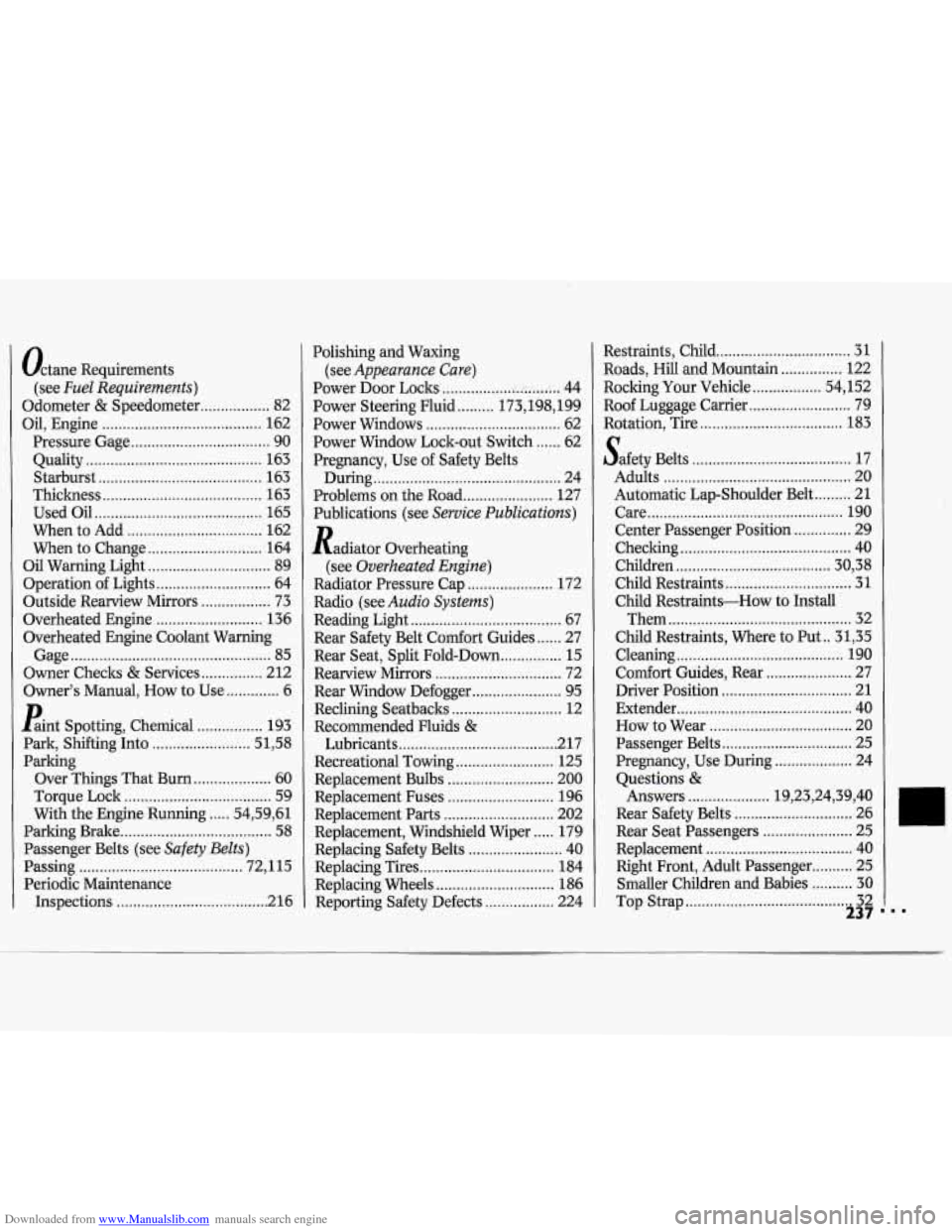
Downloaded from www.Manualslib.com manuals search engine Octane Requirements
Odometer
& Speedometer ................. 82
(see
Fuel
Requirements)
Oil. Engine ....................................... 162
Pressure Gage
.................................. 90
Quality
........................................... 163
Starburst
........................................ 163
Thickness
....................................... 163
Used Oil
......................................... 165
When
to Add ................................. 162
When to Change
............................ 164
Oil Warning Light
.............................. 89
Operation of Lights
............................ 64
Outside Rearview Mirrors
................. 73
Overheated Engine
.......................... 136
Overheated Engine Coolant Warning Gage
................................................. 85
Owner Checks & Services ............... 212
Owner’s Manual. How to Use
............. 6
paint Spotting. Chemical
................ 193
Park. Shifting Into
........................ 51. 58
Parking
Over Things That Burn
................... 60
With the Engine Running
..... 54.59. 61
Passing
........................................ 72. 115
Inspections
..................................... 2 16
Torque
Lock
.................................... 59
Parking Brake
..................................... 58
Passenger Belts (see Safety Belts)
Periodic Maintenance Polishing
and Waxing
Power Door Locks
................. i. ........ ;. 44
Power Steering Fluid
......... 173,198, 199
Power Windows
................................. 62
Power Window Lock-out Switch
...... 62
Pregnancy, Use of Safety Belts
During
.............................................. 24
Problems on the Road
...................... 127
Publications (see
Service Publications)
Radiator Overheating
(see
Overheated Engine)
Radiator Pressure Cap ..................... 172
Radio (see
Audio Systems)
Reading Light ..................................... 67
Rear Safety Belt Comfort Guides
...... 27
Rear Seat, Split Fold-Down
............... 15
Rearview Mirrors ............................... 72
(see
Appearance
Care)
Rear Window Defogger ...................... 95
Reclining Seatbacks
........................... 12
Recreational Towing
........................ 125
Recommended Fluids
&
Lubricants ....................................... 217
Replacement Bulbs
.......................... 200
Replacement Fuses
.......................... 196
Replacement Parts
........................... 202
Replacement, Windshield Wiper
..... 179
Replacing Safety Belts
....................... 40
Replacing Tires
................................. 184
Reporting Safety Defects
................. 224
Replacing Wheels
............................. 186
Restraints. Child ................................. 31
Roads. Hill and Mountain
............... 122
Rocking Your Vehicle
................. 54. 152
Rotation. Tire
................................... 183
Roof Luggage
Carrier
......................... 79
S afety Belts ....................................... 17
Adults .............................................. 20
Automatic Lap-Shoulder Belt
......... 21
Care
................................................ 190
Center Passenger Position
.............. 29
Checking
.......................................... 40
Children
...................................... 3 0, 38
Child Restraints
............................... 31
Child Restraints-How to Install
Them
............................................. 32
Child Restraints, Where to Put
.. 31, 35
Cleaning
......................................... 190
Comfort Guides, Rear
..................... 27
Driver Position
................................ 21
Extender
........................................... 40
How to Wear ................................... 20
Passenger Belts
................................ 25
Pregnancy, Use During
................... 24
Questions
&
Answers .................... 19,23,24,39, 40
Rear Safety Belts ............................. 26
Rear Seat Passengers
...................... 25
Right Front, Adult Passenger
.......... 25
Smaller Children and Babies
.......... 30
Replacement .................................... 40
Top Strap
......................................... 32
237